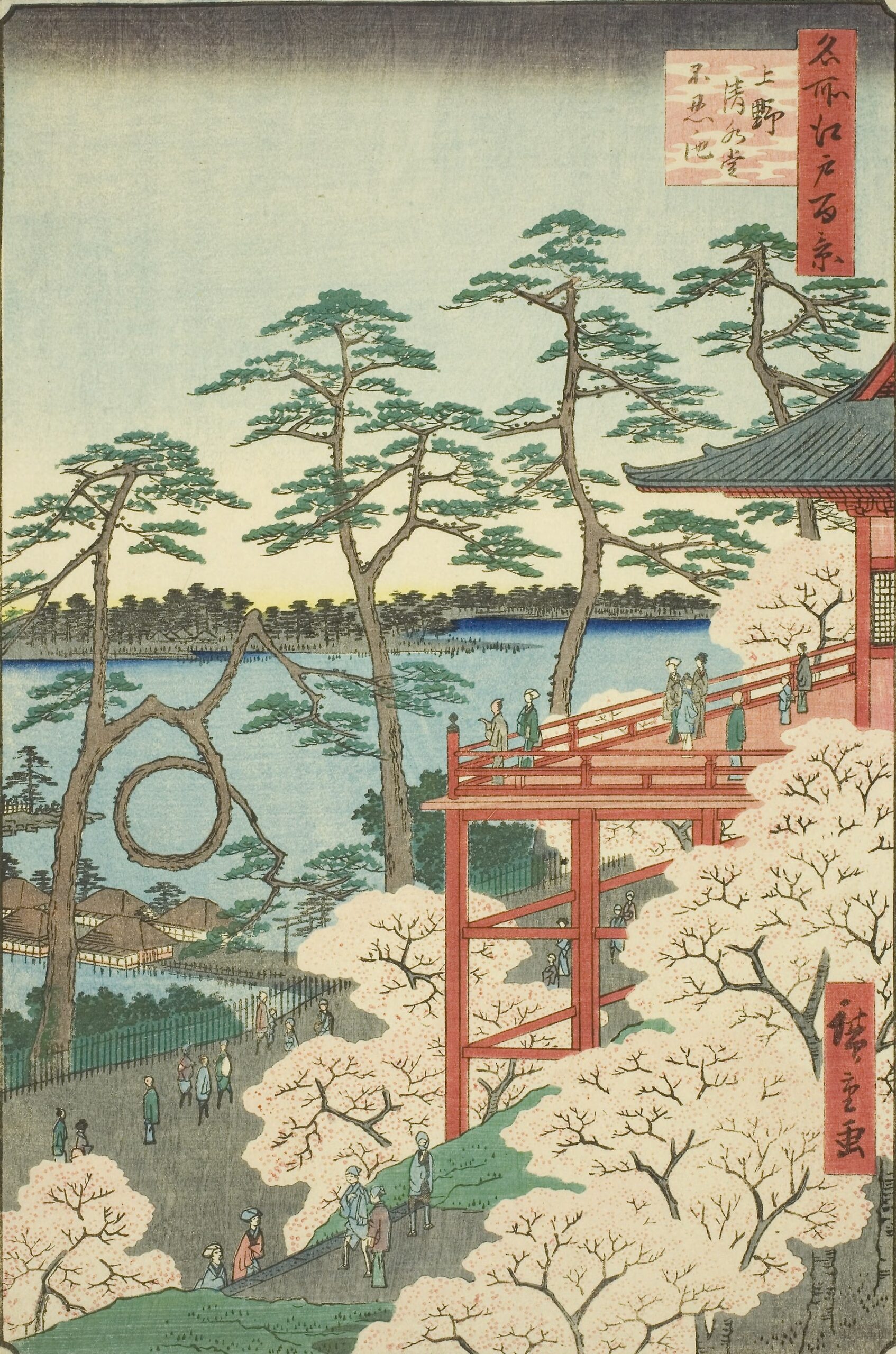
Utagawa Hiroshige – One Hundred Famous Views of Edo – 11 – Spring – Shinobazu Pond, Kiyomizu-do Hall, Ueno 歌川広重-名所江戸百景-11-春-上野清水堂不忍ノ池 解説
Current Address: Shinobazu Pond, Ueno Park, Taito Ward
Latitude and Longitude: Latitude 35.7108, Longitude 139.7703
Published: April 1856 Age: 60
Explanation
<1> Introduction
“Shinobazu Pond, Kiyomizu-do Hall, Ueno” depicts Mount Ueno (Kan’ei-ji Temple), one of Edo’s most popular tourist destinations, and Shinobazu Pond at its base.
The stage-style hall, reminiscent of Kyoto’s Kiyomizu-dera Temple, and the scenic pond at its waterfront are captured in one image, conveying to the present day the view that Edo residents boasted of as “a famous spot in the eastern capital.”
<2> Ueno Kiyomizu-do and Kan’ei-ji Temple
Kan’ei-ji Temple is a large Tendai Buddhist temple founded by the priest Tenkai in 1625 during the reign of Tokugawa Iemitsu.
As a place of prayer for the Tokugawa shogunate, it protected Edo Castle from the evil spirits and became a spiritual pillar of Edo.
Kiyomizu Kannon-do Temple, built on a hill overlooking Shinobazu Pond, has a stage-like structure modeled after Kiyomizu-dera Temple in Kyoto.
From here, common people of Edo could enjoy a panoramic view of Shinobazu Pond and the city of Edo, and the spectacular views were popular.
Kannon-do Temple was not only a place of worship for Kannon Bodhisattva, but also a tourist spot where people could enjoy the view of the pond.
This place, where faith and entertainment combined, was a perfect holiday destination for common people of Edo.
During the Edo period, Shinobazu Pond was said to have measured 20 cho (approximately 2,189 m) in circumference.
Since the Meiji period, it has been filled in and reduced to about half its original size.
Shinobazu Pond is a natural pond that collects spring water from the Musashino Plateau and covers an area of approximately 110,000 square meters.
It was once used for agricultural irrigation.
During the Edo period, cherry blossoms and lotus trees were planted and the pond was developed as a scenic spot.
An artificial island, Nakajima, was constructed in the center of the pond, and the Bentendo Hall, dedicated to Benzaiten, was built there.
It is said to have been modeled after Chikubushima Island in Lake Biwa, and became a center of faith and entertainment for the common people of Edo.
With cherry blossoms in spring, lotus flowers in summer, autumn leaves in autumn, and snowy scenery in winter, the pond entertained people throughout the year.
<3> Highlights of the Painting
The painting depicts Shinobazu Pond from the stage of Kiyomizu-do Hall.
The magnificent view of the pond below, the distant mountains, and the Edo cityscape is what makes it the “Edo Observatory.”
The stage of Kiyomizu-do Hall is depicted on the left, with people leaning on the railing.
Its miniature-like appearance of Kyoto’s Kiyomizu-dera Temple made the longed-for Kyoto of the Edo people seem closer to home.
You can also make out Nakajima Island floating in the center of the pond, with Bentendo Hall standing on it.
The light reflected on the water’s surface creates a tranquil atmosphere.
Mount Fuji is depicted majestically in the distance against the clear air.
An essential presence in Edo’s famous places paintings, it combines faith with scenic beauty.
The pine tree with branches forming a circle below the hall is the “Moon Pine.”
The red building on the right is Kiyomizu Kannon-do Hall.
Cherry trees have been planted in the foreground on the right.
Dejima on the left is Nakajima Island. Nakajima was home to several restaurants serving lotus dishes, its specialty.
<4> Edo Commoners and Their Enjoyment of Uenoyama
The standard course of action was for people to visit Kiyomizu-do Hall and then admire the view from the stage.
Many people would enjoy sake and sweets while overlooking Shinobazu Pond, making it a popular social gathering spot for the common people.
Shinobazu Pond offered rental boats, and it was popular to float on the pond and worship at Bentendo Hall or admire the scenery.
The area was especially lively during summer evenings and cherry blossom viewing season.
Ueno was a culturally rich area, home to temples, shrines, and teahouses, and was visited by many haiku poets and painters.
<5> Modern-day Ueno and Shinobazu Pond
Since the Meiji period, the grounds of Kan’ei-ji Temple have become Ueno Onshi Park, transformed into a collection of cultural facilities such as a zoo, museums, and art galleries.
Even today, Kiyomizu Kannon-do Hall and Shinobazu Pond retain their original appearance.
In summer, the pond is covered in blooming lotus flowers, creating a view that is hard to believe is in the heart of Tokyo.
Waterfowl visit in winter, making it a great place to observe nature throughout the seasons.
The view from the stage of Kiyomizu Kannon-do Temple is still as beautiful today.
We today can enjoy the same views that the people of Edo admired from the same spot.
<6> Tourist Guide
1. The Stage of Kiyomizu Kannon-do Temple
This is a place where you can experience the composition depicted in Hiroshige’s painting.
You can enjoy a panoramic view of the pond and the Tokyo cityscape.
2. The Four Seasons of Shinobazu Pond
From cherry blossoms in spring, lotus flowers in summer, autumn leaves, and migratory birds in winter, you can enjoy a visit in any season.
3. Visiting Bentendo Temple
Bentendo Temple, located on an island in the pond, still attracts many worshippers.
It is said to bring good fortune in the arts and financially.
4. Strolling around Ueno Park
The attraction of visiting Ueno Park is that you can enjoy both culture and nature at the same time, along with visiting museums, art galleries, and the zoo.


